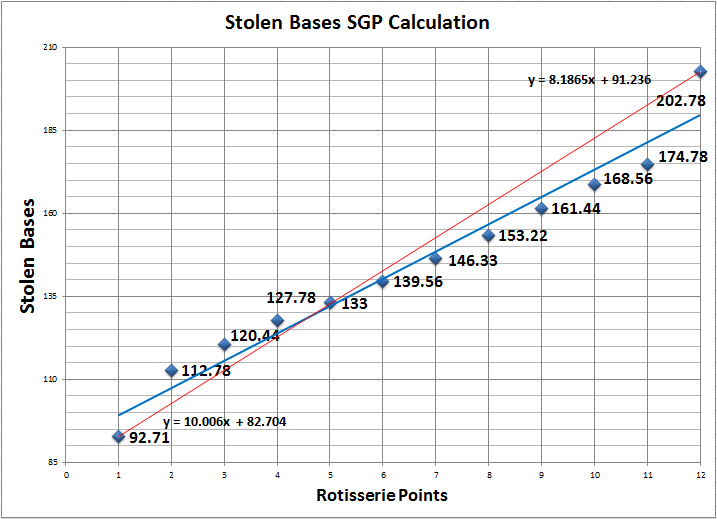Welcome to the final of a three-part series in which we take a closer look at an improved method of determining standings gain points factors. In the first part of the series we looked at the difference between my old method of calculating standings gain points factors and the improved approach suggested by Art McGee in his book, How to Value Players for Rotisserie Baseball. In the second part of the series we looked at how to implement the SLOPE function in Microsoft Excel.
In this final part of the series we take a closer look at how these SGP changes affect the end rankings.
Old Vs. New
As I alluded to in part two, I’ve been tracking the standings history (link to view Excel file) for my favorite league for several years and I use this history to calculate my SGP factors. Here’s a summary of the factors calculated under my old approach stacked up against the factors as calculated by the SLOPE function suggested by Art McGee in How to Value Players for Rotisserie Baseball.
| Stat | Old Approach | SLOPE Approach | % Change |
|---|---|---|---|
| BA | 0.00184 | 0.00169 | -8.15% |
| HR | 9.63059 | 8.87013 | -7.90% |
| R | 24.82973 | 22.02314 | -11.30% |
| RBI | 25.05772 | 22.30803 | -10.97% |
| SB | 10.00577 | 8.18620 | -18.19% |
| ERA | -0.10587 | -0.08817 | -16.72% |
| K | 35.14141 | 31.6227 | -10.01% |
| SV | 6.41558 | 5.69641 | -11.21% |
| W | 3.34776 | 2.95793 | -11.64% |
| WHIP | -0.01788 | -0.01518 | -15.10% |
What Stands Out?
Stolen bases! The SGP factors above all decreased when converting to the SLOPE calculation, making it easier to earn a standings gain point in each category. That doesn’t necessarily mean anything because of the replacement level adjustments made. If all categories became equally easier to earn SGPs in, then nothing would have changed. But stolen bases decreased significantly more than any other hitting category, meaning it became relatively easier for a player to earn SGPs in the stolen bases category.
What Does This Mean To Me?
It may mean nothing. I would recommend you perform your own SGP calculations for your league’s specific settings. Then it will be up to you to determine the effect the SLOPE calculation will have on your rankings. Or you could use Razzball’s factors, which are based upon a much larger sample size than the history of my league.
Why Did Stolen Bases Change So Much?
Because of the outliers that were affecting the calculation. The first place team in stolen bases (in my league at least) has a tendency to blow everyone out of the water while the last place team has finished nowhere near the next to last finisher. Calculating SGP off of these outliers is not the most accurate depiction of what it really takes to gain a point in the standings. Looking at spots 2 – 11, the middle teams, you see that 8 points is about all it takes to move up in the standings. 10 is actually overkill.
What Does This Do To Player Values?
Does This Seem Reasonable?
Special Thanks To Art McGee
If you missed an earlier part of this series, I got the idea for the SLOPE formula from Art McGee, who has published his approach to using standings gain points in his book, How to Value Players for Rotisserie Baseball.
NOTE: I have provided an affiliate link (what’s an affiliate link?) to the book on Amazon to the right, but at the time of writing, I don’t suggest you buy it from Amazon. It seems like the book is difficult to come by and the prices are quite high. The link is just so you can see the book and read the summary, or maybe the prices will come down in the future. If you do want to purchase McGee’s book, Baseball HQ is selling them on a close out sale for $8.95 plus S&H. That’s where I got my copy.
Want More In-Depth Analysis Like This?
Thanks For Reading
Make smart choices.
